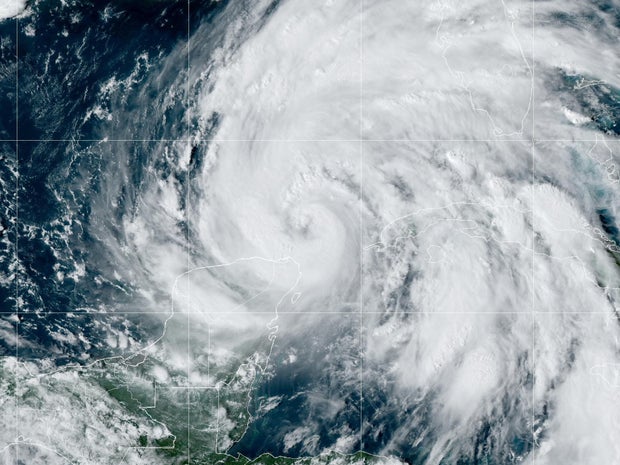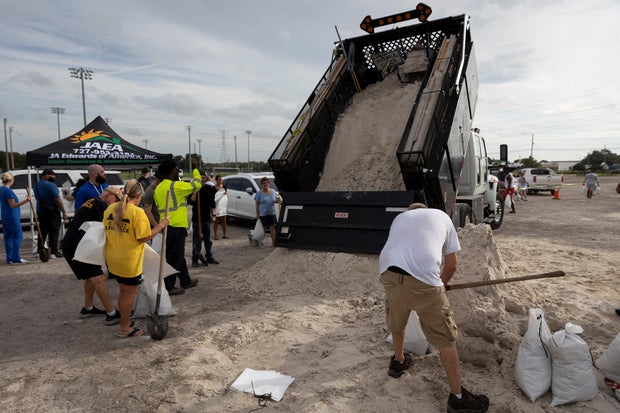Hurricane Helene is heading toward Florida and is expected to strengthen significantly before making landfall

Hurricane Helene continued to gain strength Wednesday as it entered the Gulf of Mexico on a path toward the Big Bend region on Florida’s Gulf Coast. The hurricane is expected to become more powerful as it moves into the warm waters of the Gulf.
The storm had maximum sustained winds of 85 mph late Wednesday afternoon, making it a Category 1 storm, according to the National Hurricane Center in Miami. The hurricane center uses five categories for hurricanes and considers storms that are at least Category 3, with sustained winds of more than 110 mph, to be a major hurricane.
“We believe there’s going to be significant strengthening here in the eastern Gulf of Mexico that could potentially make this a Category 3 or major hurricane,” Jamie Rhome, deputy director of the hurricane center, told CBS News on Wednesday.
In the hardest-hit coastal communities, framed homes could sustain significant damage or have their roofs removed, the hurricane center said. Many trees will be snapped or uprooted, blocking roads. Power and water will likely be unavailable for several days or weeks after the storm passes.
Gov. Ron DeSantis told reporters Wednesday that thousands of power line workers would come to the state to restore power after the storm passes.
“There are going to be power outages, so people have an opportunity to prepare for them now,” DeSantis said. “You still have time to make preparations and put your plan into place today, but time is running out.
The storm is expected to bring “life-threatening storm surge, high winds and torrential rains to much of Florida and the southeastern United States,” the National Hurricane Center said.
In the Big Bend region of Florida, south of Tallahassee from Carrabelle to the Suwannee River, forecasters expected water to reach 15 to 20 feet above ground level if the storm surgeThe storm’s peak occurred at the same time as high tide. Other areas could see between 3 and 15 feet of water, the hurricane center warned.
“The water impacts will probably be the most impactful part of the storm, the deadliest part of the storm,” Rhome said.
NOAA/NESDIS/STAR GOES-East
Alerts and warnings were issued across Florida ahead of the storm. President Biden and DeSantis declared a state of emergency in the state earlier this week, and evacuation orders Evacuations were ordered in several counties. At the University of Tampa, officials were trying to evacuate all resident students Wednesday afternoon.
Helene is expected to make landfall Thursday, and it won’t just affect Florida, Rhome said.
“I’m really concerned that south Georgia is going to have a significant impact well beyond where the center makes landfall,” Rhome told CBS News.
DeSantis discouraged Floridians from traveling hundreds of miles from home to escape the storm, as Helene was expected to move inland after landfall.
“If you look at how this storm is going to move, it’s going to hit the northern part of Florida, and it’s going to continue to move, and it’s going to hit southern Georgia, it’s going to probably hit Atlanta, it’s going to hit the Tennessee-Carolina area and just kind of stop, so Florida, we’re just kind of the opening act,” DeSantis said.
The governor instead urged people to move to higher ground in their own areas by going to a friend or family member’s house or to a shelter.
Florida Prepares for Hurricane Helene
Along the west coast of Florida, residents were prepare for the storm by boarding up windows, filling their vehicles with fuel and filling sandbags before Helen’s potentially dangerous move.
In Tallahassee, Dorothy Richardson was preparing to move in with six of her grandchildren.
“No matter what the situation, I have to be prepared,” Richardson said. “I take my sandbags…my charcoal, my lighter fluid, my propane tank.”
Reuters/Marco Bello
Russell King was preparing to evacuate his Mexico Beach home. He said the house barely held up Hurricane Michael in 2018.
“We lost our shower, our elevator, all the walls on the ground floor,” King said. “We think we’re OK now, but we don’t know – at 125 mph, they’re flying off.”
Tallahassee Mayor John Dailey said the city was doubling its staff with crews from other states coming to help restore power and provide aid in the area after Helene.
“It’s very concerning,” Dailey said. “I’m from Tallahassee, it’s my hometown. We’ve never seen a storm of this magnitude that could hit Tallahassee directly.”
Further south in Tampa, a makeshift wall was set up outside Tampa General Hospital to keep water from entering the nearby bay. The area was expected to see a storm surge of 5 to 8 feet. Officials said the wall held back about 2.5 feet of water last year, when Hurricane Idalia hit.
Warm Gulf Water Fuels Hurricane
Gulf water, which has reached record temperatures, would act like jet fuel in intensifying the storm. Brian McNoldy, a senior research scientist at the University of Miami’s Rosenstiel School of Marine, Atmospheric and Earth Sciences, recently noted that Heat content of the oceans in the Gulf of Mexico is the highest ever recorded. Hot water is a necessary ingredient to strengthen tropical systems.
Sea surface temperatures in Helene’s path could reach 31 degrees Celsius, or 1 to 1.5 degrees Celsius above normal. These record-breaking water temperatures have become much more likely due to human-caused climate change, according to Climate Central. The North Atlantic Ocean as a whole experienced record-breaking temperatures in 2024, storing 90% of the excess heat from Tropical Storm Helene. climate change produced by greenhouse gas pollution.
Florida Radar Map
Ahead of Helen’s expected landfall in Florida, this radar map shows precipitation across the state.
Manuel Bojorquez contributed to this report.






